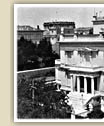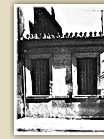
Neoclassicism was the most common architectural style of the period, especially among the liberal
bourgeois class; it gratified their desire both for social ostentation
and the Great Idea.
Anastasios Metaxas was a prominent architect of this era. He gave
Classicism a modern purity and cleansed it from alien elements of form
with a strong use of white colour (as in the Benaki Museum).
At the same time, the French Neo-baroque was still pursued (as in the Ionian and Popular Bank,
Pesmazoglou Street), while new forms combined elements of different backgrounds. Thus, in the suburbs of Athens but also in the suburbs of other
cities such as Patra and Ermoupolis, bourgeois mansions were built using native architectural traditions mixed in with eclectic elements. Such are the Art Nouveau houses,
the rustic and 'pink houses'. They are all samples of a 'picturesque architecture' that was interested in functionalism and simplicity.
In the same period the first systematic attempt at building schools was made, with
the series of the 400 school buildings by D. Kallias, known as the 'Syngros Schools',
characterized by the formal monumental composition of Classicism.
Similarly, the Great Idea was accepted by all social classes, and
Classicism spread widely and prevailed as the national architecture of Greece throughout the
nineteenth century.
|
 |

Neoclassical styles were also to be seen in this period, especially in the 'anonymous' architecture
of the lower-income households, whereas the bourgeoisie gradually abandon it.
The form became standardized but preserved its picturesque nature. Whole quarters
around the centre of Athens (Kolonos, Metaxourgio, Neapolis, Plaka, Petralona, Ardittos) still offer examples of such
humble houses, built in the first quarter of the twentieth century: a closed front towards the street, an interior
courtyard, an upper storey gallery with window panes and a Classical facade, with decorative
terracotta corner tiles. Detatched and semi-detatched houses designed for
households of one or more persons with common rooms (kitchen, lavatory) also developed in this period.
The Neoclassical style was not only evident in urban centres, but
in the countryside as well. The provincial Classicism of towns and villages at the beginning of
the twentieth century shows the participation of the upper class in a new culture. By contrast, the
lower class was more or less attached to traditional architecture. A large variety of types and scale can be found
in the provincial architecture of the time.
At the beginning of the twentieth century, an interest
in traditional architecture and the move to create a Greek style emerged. There are several reasons for this: one can look to the observations and encouragement of
P. Yannopoulos, who felt an aversion for Classicism and who sought a Greek architecture based on tradition and
adjusted to Greek needs; one can also cite Ion Dragoumis, who believed that the pursuit of modern Greek architecture
should be based on the Byzantine tradition; and, finally the inevitable decline of Classicism should be borne in mind.
Greekness in architecture was advocated by Dimitrios Tsitouras, through his writings and
designs, by Emmanouil Kriezis, who was most interested in the architecture of the Greek countryside.
Throughout this period, however, no architect seems to have been practically engaged with traditional architecture.
This only occurred in the following era, chiefly with Aristotelis Zachos. After studying Byzantine architecture he promoted the model of
a native, popular architecture by adapting traditional architectural models with modern materials.
|
 |
